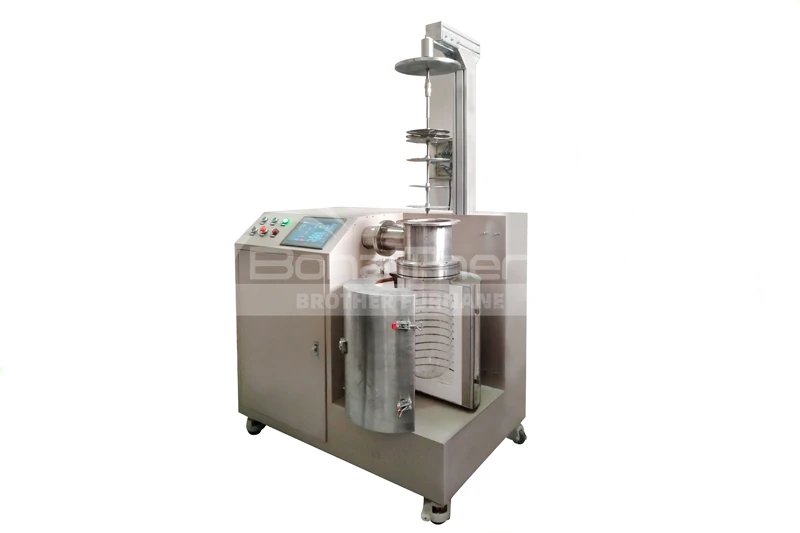What Are the Differences Between Gas Quenching and Oil Quenching?
Gas quenching and oil quenching are two commonly used quenching methods. In
the field of metal heat treatment, the quenching process is a critical part of
ensuring material properties.
Gas quenching and oil quenching each have unique advantages, disadvantages, and scope of application. The differences between the two not only affect the final properties of the metal but also determines which quenching equipment is selected for the process.
In this article, as a professional vacuum quenching furnace manufacturer,
Brother Furnace will delve into the key differences between gas quenching and
oil quenching to help you understand which method is best suited for your
production needs.
What is Gas Quenching and Oil Quenching?
Definition of Gas Quenching
Gas quenching is the process of rapidly cooling a metal workpiece that has been heated to an appropriate temperature by placing it into a gas. Commonly used gases include inert gases such as nitrogen and helium.
The main advantage of this method is its controlled cooling rate, which effectively reduces thermal stress and distortion, thus ensuring stable workpiece geometry and properties. In addition, the gas quenching process is virtually free of corrosion on the workpiece surface caused by liquid media, making it suitable for handling high-value and precision parts.
Definition of Oil Quenching
Oil quenching is a process in which a heated metal workpiece is immersed in oil for rapid cooling. Due to the excellent thermal conductivity of oil, it can quickly remove the heat from the workpiece, thus realizing rapid cooling.
Oil quenching is usually used for materials requiring high hardness and toughness, and is particularly effective in the treatment of tool and alloy steels. Different types of oils (e.g. mineral oils and synthetic oils) can have different effects on the cooling effect, so careful consideration needs to be given to the nature of the oil when selecting an oil quenching process.
Main Differences between Gas Quenching and Oil Quenching
Characteristics | Gas Quenching | Oil Quenching |
|---|---|---|
Cooling medium | Gas (e.g. nitrogen, air) | Liquid (oil) |
Cooling rate | Slower (below 20°C/s) | Faster (above 50°C/s) |
Applicable materials | Low-alloy steel, stainless steel | high-carbon steel, alloy steel |
Risk of deformation | Lower | Higher |
Risk of cracking | Lower | Higher |
Workpieces | For complex shapes or thin-walled workpieces | For simple shapes or thick-walled workpieces |
Increased hardness | Well, with better toughness | Better, but prone to cracking |
Differences in Cooling Media
Gas quenching: Generally using gas as the cooling medium, with low thermal conductivity, and good flow uniformity, to avoid localized overheating or uneven cooling of the workpiece in the cooling process, suitable for processing complex shapes of workpieces.
Oil quenching: Liquid oil is used as the cooling medium. There are various types of oil, including mineral oil, synthetic oil and so on. Oil has high heat transfer efficiency, and can quickly take away the heat, so that the metal cools down quickly. Still, the viscosity and evaporation characteristics of the oil will affect the cooling efficiency.
Different Cooling Rates
Gas quenching: The cooling rate is relatively slow, usually between 10 and 50 degrees per second. It is suitable for the treatment of high alloy steel and stainless steel. These materials are prone to cracking and deformation during oil quenching.
Oil quenching: The cooling rate of oil quenching is relatively fast, usually between 10 and 100 degrees per second. Oil quenching is suitable for carburized steel, alloy steel, and other workpieces that require high hardness, which can significantly improve the hardness and strength of the material.
Applicable Materials
Gas quenching: Suitable for high alloy materials and stainless steel, etc. These materials are prone to cracking or deformation in the oil quenching process, while gas quenching can effectively reduce this risk. The cooling rate of gas quenching can be adjusted, making it adaptable to many different types of metals.
Oil quenching: It is suitable for low alloy steel and high carbon steel, etc.
It can significantly improve the hardness and strength and is ideal for the
production of tools, molds, and other products that require high hardness and
wear resistance. Oil quenching also has certain requirements on the thickness
and shape of the material, and overly complex shapes may lead to uneven
cooling.
Different Costs and Efficiency
Gas quenching: The cost of gas is relatively high, and the investment in equipment is also larger, but due to precise cooling control, the production efficiency is higher and suitable for mass production. Gas quenching furnace usually requires a high-pressure system and has relatively high running costs, but the overall benefits are significant in the long run due to its reduced material losses.
Oil quenching: The cost of oil is relatively less and the investment in equipment is also less. Oil quenching equipment is generally simple in structure and easy to maintain. Although the cooling efficiency of oil quenching is high, it requires regular replacement of the oil and the treatment and recovery of oil have a certain impact on the environment.
Different Processes
Gas quenching: Gas flow, temperature, and pressure can be precisely controlled during gas quenching to optimize the cooling of the workpiece. Brother Furnace's vacuum gas quench furnaces are equipped with advanced temperature monitoring systems to ensure stability and consistency of the quenching process.
Oil quenching: In the oil quenching process, factors such as the temperature,
viscosity, and cooling rate of the oil have a direct impact on the final result.
Improper use may lead to bubbles, inclusions, and other defects on the surface
of the workpiece, affecting the quality of the workpiece. Therefore, the nature
of the oil needs to be strictly monitored and adjusted.
Advantages and Disadvantages of Gas Quenching and Oil Quenching
Gas Quenching
Advantages:
● Suitable for high alloy and stainless steel materials, reduces thermal stress and distortion.
● Adjustable cooling rate, highly adaptable.
● Less likely to cause surface corrosion, suitable for precision parts.
Disadvantages:
● High investment in equipment and relatively high operating costs.
● A slower cooling rate, may not be suitable for some low alloy steel treatments.
Oil Quenching
Advantages:
● A fast cooling rate, can improve the hardness and strength of the material.
● Relatively low equipment and material costs, suitable for mass production.
Disadvantages:
● Easily leads to oxidization and corrosion on the surface of the workpiece.
● High safety requirements for operators, volatilization, and handling of oil require special attention.
How to Choose a Suitable Quenching Process?
Brother Furnace reminds you that the selection of a suitable quenching process requires comprehensive consideration of a number of factors, including the type of material, the shape of the workpiece, the required performance, and economy.
Material type: If you are dealing with high alloy steel or stainless steel,
gas quenching may be more appropriate; if it is for low alloy steel or high
carbon steel, oil quenching can better improve the hardness.
Workpiece shape: For complex-shaped workpieces, the advantage of gas quenching is uniform cooling, avoiding localized overheating and deformation.
Production scale: In the case of large-scale production, oil quenching may be more economical considering the investment and operating costs of the equipment.
Requirements of performance: According to the needs of the performance of the final product, select the appropriate cooling rate and medium to ensure that the mechanical properties of the metal material meet expectations.
Brother Furnace: A Professional Quenching Furnace Manufacturer
Through the above analysis, you can see the main difference between gas quenching and oil quenching.
With its controllability and adaptability, gas quenching is suitable for the treatment of high alloy and stainless steel, while oil quenching is widely used for low alloy and high carbon steel by its rapid cooling ability.
As a manufacturer of vacuum gas quenching furnaces and vacuum oil quenching furnaces, Brother Furnace is committed to providing high-quality devices to help
you optimize your production process and improve product quality.
Choosing the right quenching process and furnaces not only improves production efficiency but also ensures the performance and quality of the final product. Brother Furnace hopes that this article can help you better understand the difference between gas quenching and oil quenching, to provide reference for your production decisions.
If you have any questions about our quenching furnace, please feel free to contact us.
Brother Furnace looks forward to working with you.











